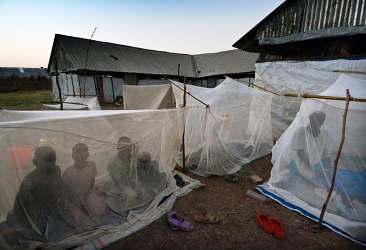Jonglei: Malaria, Malnutrition on the rise after violent clashes
By Julius N. Uma
February 5, 2012 (JUBA) — 16-year old Nyayan Giet lies helpless on a
metallic bed in a maternity ward at Walgak Primary Health Care Center
(PHCC) as she quietly stares at at roof with no ceiling. Her husband
and a relative closely monitor her condition.

giving birth to her baby,” Rebecca Nyabuom, a community midwife at the
center tells Valerie Amos, the United Nations Emergency Relief
Coordinator.
Walgak, a village located in South Sudan’s Jonglei state county of
Akobo has approximately 6,000 people, according to the 2008 population
and housing census.
The area, which currently has some 50 UN peacekeepers and about 100
organized forces came under attack between December 28 and January 10
displacing thousands of the population.
Rebecca Nyabuom, a midwife speaking to Valerie Amos, the UN
Humanitarian Coordinator at Walgak Primary Healthcare Center (Photo by
Julius Uma)
David Ruei Guem, a community health worker at the healthcare center
says Malaria, Malnutrition and Diarrhea are the worst reported cases
among children at the facility, established the International Medical
Corps (IMC) in 2003.
“Surprisingly, we have very few cases of children suffering from
measles recorded at the center,” says the 29-year old health official.
In recent months, Walgak PHCC has become a hub where heath workers
grapple with thousands of the populations displaced in what many have
termed as the worst ethnic violence in South Sudan’s post-session era.
Amos, the UN Humanitarian Coordinator who led a team that visited
Walgak and later Pibor on Thursday, described the humanitarian
situation in both areas as “extremely” serious, adding that UN was
overstretched in its efforts to respond to the emergency needs of over
88,000 displaced in Pibor alone.
“The humanitarian situation is extremely serious,” said Amos, adding
that, “[And] currently the UN is extremely stretched to manage the
overwhelming situation in the region.”
She however pledged to continue lobbying for more support to address
the plight of those affected by the wave of ethnic violence, which the
UN estimates to have displaced more than 120,000 people in Jonglei
state.
Last month, South Sudan government declared Jonglei a disaster zone
after violence, which started last year in April, June and later
August between the Murle and Luo Nuer communities escalated in
December and continued mid-way through January this year.
An inter-agency humanitarian assessment carried in the conflict
affected areas identified food, water, heath and sanitation as the
most urgent needs of the conflict- affected population.
The UN, Amos said, has already earmarked $760 million as humanitarian
aid for South Sudan alone. Most of the funds, she added, will be
directed towards food provision, health care, water, sanitation and
hygiene assistance.
Although poor infrastructures were cited as major setbacks to
effective responses from aid agencies, the UN Humanitarian Coordinator
lauded the operational coordination hub established in Pibor to
respond to conflict affected areas in and around the town.
Currently, a total of 17 humanitarian organizations are providing
live-saving assistance to the population in Pibor, compare to only
eight reportedly in operation in the region prior to the latest
outbreak of violence.
WORSE MALNUTRITION CASES
Loud cries also welcomed the UN Emergency Relief Coordinator as she
visited Pibor Boys Primary School. The school facility, which was
established in 1956, has temporarily been transformed into an
emergency health center for handling malnutrition cases.
MEDAIR health workers (in blue) attend to children affected by
Malnutrition in Pibor Boys Primary School in Pibor County, Jonglei
state (Photo by Julius Uma).
A team of workers from the medical charity organization, MEDAIR are
busy taking measurements of children to determine the exact heights of
visibly malnourished children, after which details are filled on a
manila paper to determine their nutritional requirements.
“As you can see,” an official narrates, “These [manila] papers are of
three different colors. A child whose details appear on a green one is
considered to be fine, while those carrying yellow and red papers
usually have moderate and severe malnutrition respectively.
Everyday, at least more than 200 malnutrition cases are registered at
the temporary health unit, according to the daily nutrition screening
sheets.
Since January this year, statistics from Medicines San Frontiers (MSF)
indicate, the number of children with malnutrition cases is eight
times that of the previous year, while that of Malaria has more than
tripled.
An estimated 9,000 children, according to UN Children Fund (UNICEF),
are currently out of schools in and around Pibor country. However, the
organization says it’s working closely with country education offices
to ensure these children, who abandoned school after the violent
clashes in the area, return to school. Pibor has 29 primary and only
one secondary schools.
Joshua Konyi, the Pibor county commissioner told the vising UN
assessment team that albeit calm had been restored in the area, more
organized forces need to be deployed in the region to avert future
attacks.
(ST)
